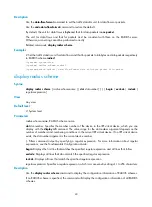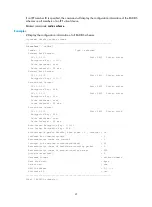
53
Parameters
None
Description
Use the
radius client enable
command to enable the listening port of the RADIUS client.
Use the
undo radius client
command to disable the listening port of the RADIUS client.
By default, the listening port is enabled.
When the listening port of the RADIUS client is disabled:
•
The RADIUS client can either accept authentication, authorization or accounting requests or
process timer messages. However, it fails to transmit and receive packets to and from the RADIUS
server.
•
The end account packets of online users cannot be sent out and buffered. This might lead to a
problem that the RADIUS server still has the user record after a user goes offline for a period of time.
•
The authentication, authorization and accounting turn to the local scheme after the RADIUS request
fails if the RADIUS scheme and the local authentication, authorization and accounting scheme are
configured.
•
The buffered accounting packets cannot be sent out and will be deleted from the buffer when the
configured maximum number of attempts is reached.
Examples
# Enable the listening port of the RADIUS client.
<Sysname> system-view
[Sysname] radius client enable
radius nas-ip
Syntax
radius nas-ip
{
ip-address
|
ipv6
ipv6-address
}
undo radius nas-ip
{
ip-address
|
ipv6
ipv6-address
}
View
System view
Default level
2: System level
Parameters
ip-address
: IPv4 address in dotted decimal notation. It must be an address of the device and cannot be
0.0.0.0, 255.255.255.255, a class D address, a class E address, or a loopback address.
ipv6
ipv6-address
: Specifies an IPv6 address. It must be an address of the device and must be a unicast
address that is neither a loopback address nor a link-local address.
Description
Use the
radius nas-ip
command to specify a source address for outgoing RADIUS packets.
Use the
undo radius nas-ip
command to remove the configuration.
By default, the source IP address of an outgoing RADIUS packet is the IP address of the outbound
interface.






























